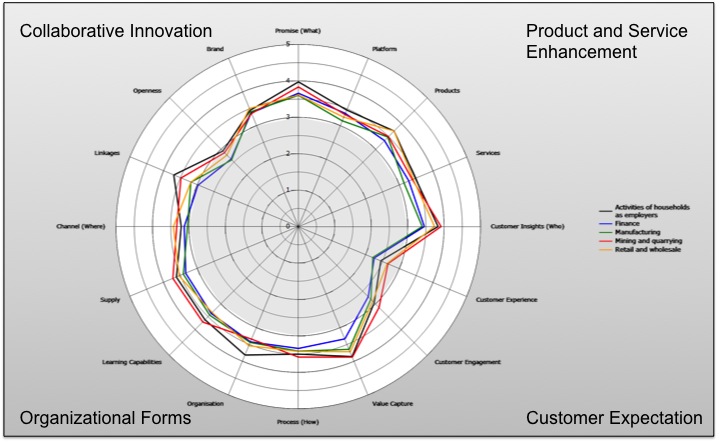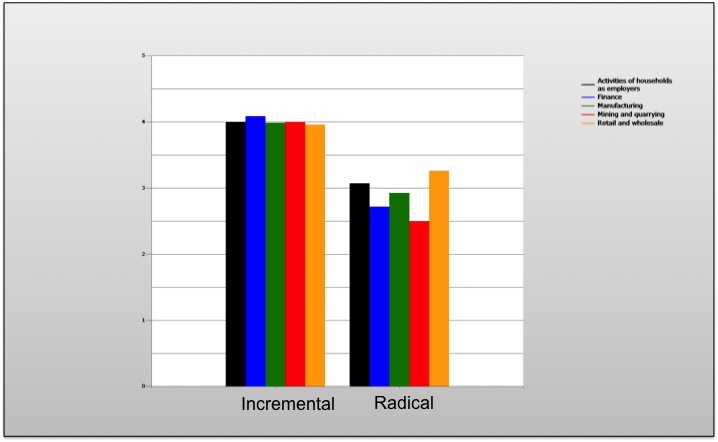The echo form the Davos meeting just begun… To quote Erik Brynjolfsson, Director of the MIT Initiative for the Digital Economy, “The idea that robots will take our jobs is the biggest misconception I’ve heard here at Davos.” Instead, he emphasized technology’s potential as a powerful tool. Or cite US Vice-President Joe Biden said “I believe, on balance, these transformations are changes for the good. But they come with real peril, and they require us to be proactive. For how will the warehouse worker who used to ship your order, or the salesman who used to take it, now make a living when he or she is no longer needed in that venture?”
Davos Innovation Analysis: Will The Fourth Industrial Revolution lead to Households as employers?
We stand on the brink of a technological revolution that will fundamentally alter the way we live, work, and relate to one another. In its scale, scope, and complexity, the transformation will be unlike anything humankind has experienced before. We do not yet know just how it will unfold, but one thing is clear: the response to it must be integrated and comprehensive, involving all stakeholders of the global polity, from the public and private sectors to academia and civil society.
Are we on the cusp of a Fourth Industrial Revolution? Most participants in Davos think so. And it’s unlike anything we’ve ever experienced: “As a society, we are entering uncharted territory,” Salesforce CEO Marc Benioff told participants on the last day of this year’s Annual Meeting.
The Fourth Industrial Revolution was on all lips in Davos, a good thing but let´s recap. The first three industrial revolutions were, in chronological order, the steam engine, electricity and electronics. The concept is connected to the Internet of Things, and provides that any product in the production chain can carry information about where and how, with the result that the factory is be able to organise itself. The goals are shorter adjustment and lead times, fewer errors, more flexibility and no time-consuming programming. Fourth Industrial Revolution is about the re-industrialisation of the Western world and it could be summarised as an extension of the possibility of connecting machines to other machines and ultimately an end-consumer somewhere in order to organise production in a smart way. At the same time, other possible future-interlinked trends taking place are:
- The 3D printing revolution, where you print everything from spare parts for air crafts to industrial high-speed fans; bio-parts to full-scale cement houses; as well as consumer products, such as toys and food;
- The omni-channel in retail and e-commerce, where consumers interact with brand owners, ultimately designing their own products and services using mobile technology for design and access, and brick-and-mortar as service points for training, service and upgrades/modifications. Another example is connected trucks interacting with the nearest service garage when it’s time for a service;
- The security revolution, where old paradigms are challenged. Classic LAN and firewall architecture are on longer capable of protecting multi-channel connections. New threats require new architecture; and
- The social revolution and global transparency, which have led to increased demand for fair training and a fair labour market but also sustainable thinking and rapid communication, where everybody with a story to tell can have an impact.
The possibilities of billions of people connected by mobile devices, with unprecedented processing power, storage capacity, and access to knowledge, are unlimited. And these possibilities will be multiplied by emerging technology breakthroughs in mentioned fields such as artificial intelligence, robotics, the Internet of Things, autonomous vehicles, 3-D printing, nanotechnology, biotechnology, materials science, energy storage, and quantum computing.
Already, artificial intelligence is all around us, from early self-driving cars and drones to virtual assistants and software that translate or invest. Impressive progress has been made in AI in recent years, driven by exponential increases in computing power and by the availability of vast amounts of data, from software used to discover new drugs to algorithms used to predict our cultural interests. Digital fabrication technologies, meanwhile, are interacting with the biological world on a daily basis. Engineers, designers, and architects are combining computational design, additive manufacturing, materials engineering, and synthetic biology to pioneer a symbiosis between microorganisms, our bodies, the products we consume, and even the buildings we inhabit.
Challenges and opportunities
Like the revolutions that preceded it, the Fourth Industrial Revolution has the potential to raise global income levels and improve the quality of life for populations around the world. To date, those who have gained the most from it have been consumers able to afford and access the digital world; technology has made possible new products and services that increase the efficiency and pleasure of our personal lives. Ordering a cab, booking a flight, buying a product, making a payment, listening to music, watching a film, or playing a game—any of these can now be done remotely.
In the future, technological innovation will also lead to a supply-side miracle, with long-term gains in efficiency and productivity. Transportation and communication costs will drop, logistics and global supply chains will become more effective, and the cost of trade will diminish, all of which will open new markets and drive economic growth.
Moreover, technological innovation will also lead to more reuse and less waste of material and energy due to economical reasons and social demands.
At the same time, as the economists Erik Brynjolfsson and Andrew McAfee have pointed out, the revolution could yield greater inequality, particularly in its potential to disrupt labor markets. As automation substitutes for labour across the entire economy, the net displacement of workers by machines might exacerbate the gap between returns to capital and returns to labor. On the other hand, it is also possible that the displacement of workers by technology will, in aggregate, result in a net increase in safe and rewarding jobs.
We cannot foresee at this point which scenario is likely to emerge, and history suggests that the outcome is likely to be some combination of the two. However, I am convinced of one thing—that in the future, talent, more than capital, will represent the critical factor of production. This will give rise to a job market increasingly segregated into “low-skill/low-pay” and “high-skill/high-pay” segments, which in turn will lead to an increase in social tensions. Discontent can also be fueled by the pervasiveness of digital technologies and the dynamics of information sharing typified by social media. More than 30 percent of the global population now uses social media platforms to connect, learn, and share information. In an ideal world, these interactions would provide an opportunity for cross-cultural understanding and cohesion. However, they can also create and propagate unrealistic expectations as to what constitutes success for an individual or a group, as well as offer opportunities for extreme ideas and ideologies to spread.
The impact on business
An underlying theme in general is that the acceleration of innovation and the velocity of disruption are hard to comprehend or anticipate and that these drivers constitute a source of constant surprise, even for the best connected and most well informed. Indeed, across all industries, there is clear evidence that the technologies that underpin the Fourth Industrial Revolution are having a major impact on businesses.
On the supply side, many industries are seeing the introduction of new technologies that create entirely new ways of serving existing needs and significantly disrupt existing industry value chains. Disruption is also flowing from agile, innovative competitors who, thanks to access to global digital platforms for research, development, marketing, sales, and distribution, can oust well-established incumbents faster than ever by improving the quality, speed, or price at which value is delivered.
Major shifts on the demand side are also occurring, as growing transparency, consumer engagement, and new patterns of consumer behavior (increasingly built upon access to mobile networks and data) force companies to adapt the way they design, market, and deliver products and services.
A key trend is the development of technology-enabled platforms that combine both demand and supply to disrupt existing industry structures, such as those we see within the “sharing” or “on demand” economy. These technology platforms, rendered easy to use by the smartphone, convene people, assets, and data—thus creating entirely new ways of consuming goods and services in the process. In addition, they lower the barriers for businesses and individuals to create wealth, altering the personal and professional environments of workers. These new platform businesses are rapidly multiplying into many new services, ranging from laundry to shopping, from chores to parking, from massages to travel.
Household as employers is mot likely the place where we will see most innovations and most new jobs in the future, Magnus Penker CEO Innovation360 Group

On the whole, and according to the Davos Economic Forum, there are four main effects that the Fourth Industrial Revolution has on business—on Customer Expectations, on Product and Service enhancement, on Collaborative innovation, and on Organizational forms. Whether consumers or businesses, customers are increasingly at the epicenter of the economy, which is all about improving how customers and consumers are served. As a CEO you need to be able to cope and understand the there are four main effects in relation to other. The diagrams below, based on data from InnoSurvey, show how ready we are in some of the large industries and the conclusion is that household as employer is a very innovative trade and someplace where we most likely will see new jobs of the future. Moreover, we can clearly see that non of the industries are really ready for radical change and disruption and all are more or less lacking of the customer capabilities. Interesting is also how Mining is more innovative industry than Manufacturing and Finance – we can clearly be better prepared and trained for the future and we will most likely see new type of jobs that was not in the focus of the Davos World Economic Forum – the households and the micro economy which in it turn are end consumers driving demand for other industries.

Global data snap-shot from InnoSurvey™ describing the four areas pointed ot by Davos as critical.
Households as employer (followed by mining) seems to be more ready for appointed aspects than Finance,
Manufacturing and Retail which also seems logical as we see a market increasingly
segregated into “low-skill/low-pay” and “high-skill/high-pay” segments.

Global data snap-shot from InnoSurvey™. Below 3 means not innovating incremental/radical.
The investigated trades are incremental and not ready for disruption. If Household as employer (and firms
organising for household services) will apply radical innovation and disruptive technology we
will most likely see new well paid jobs here.

